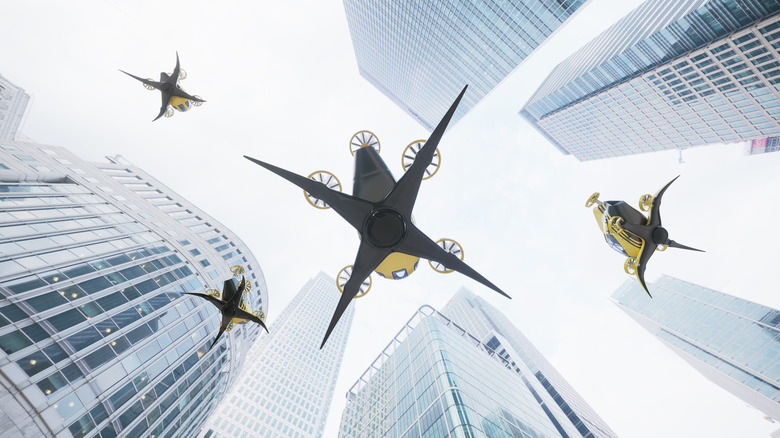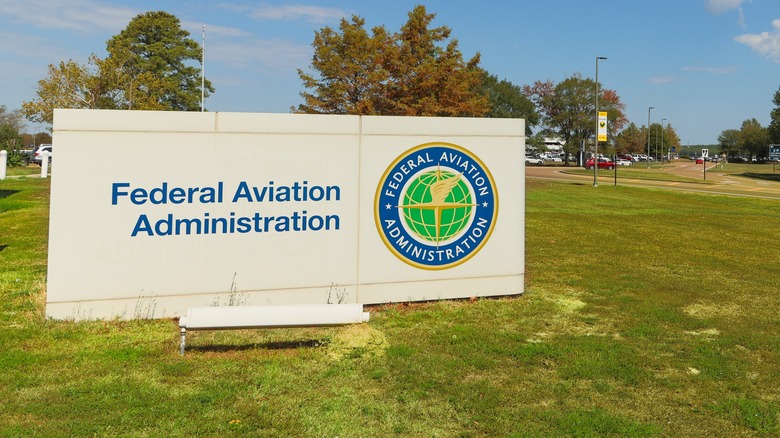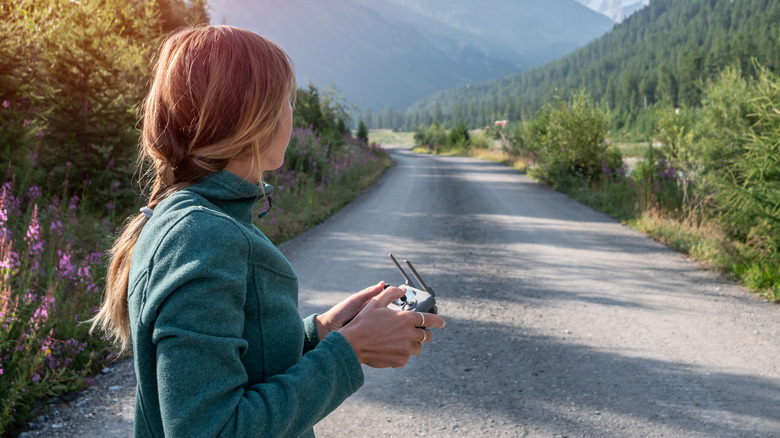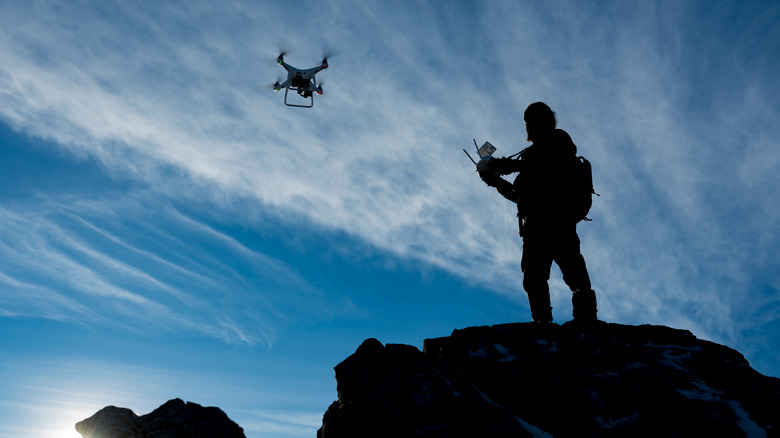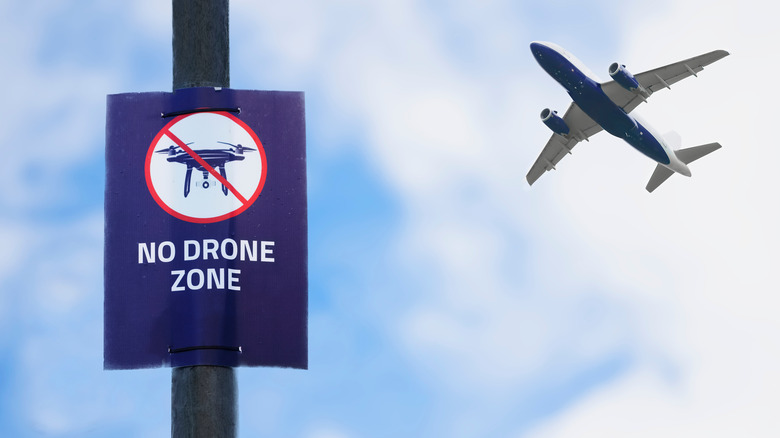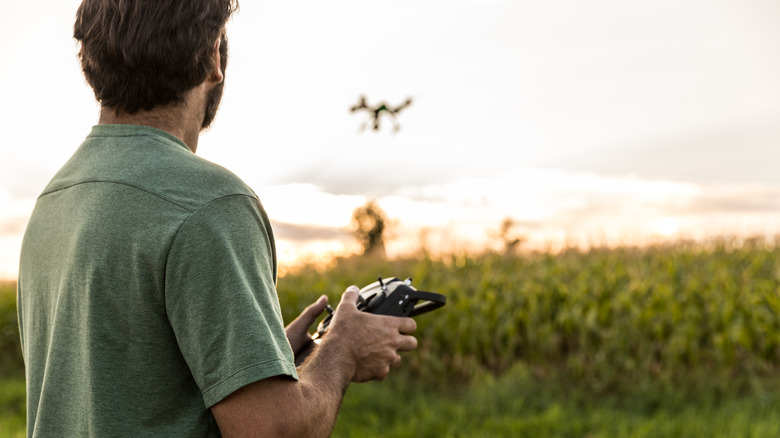Laws And Regulations You Need To Be Aware Of Before Buying A Drone
A remote-controlled drone is a nifty way to take control of the skies — or at least the sky directly above your home. Using these devices allows you to carry small objects, monitor your home, and in the case of models with remote cameras, explore the world from above and take photographs. However, while drones of all shapes and sizes are readily available from all kinds of commercial storefronts, that doesn't mean you can just buy one and start cruising over your neighborhood.
As a drone is a flying device, its operation falls under the purview of the Federal Aviation Administration, the United States government body that holds dominion over all things that fly. Specifically, the operation of all drones falls under the FAA's "The Recreational UAS Safety Test," (or "TRUST") for recreational flight and the Small UAS (Unmanned Aircraft System) Regulations (Part 107) for commercial flight. If you don't follow the proper rules and regulations, not only could you find yourself saddled with some hefty fines, but you could end up endangering yourself and others. Even if you only plan on using your device in your backyard, you'd do well to familiarize yourself with the complete operation rulebook.
Drone registration and certification
Before you can even think of operating a drone, you need to get it registered and certified with the FAA (unless it weighs 0.55 pounds or less). Similarly to how you can't fly an unlicensed airplane, you can't operate a drone until its existence and specs have been registered with the government agency and certified to be safe to operate.
First, after purchasing a drone, you'll need to visit the FAA's drone website to fill out a registration form. This costs $5, so make sure you have a payment method handy. After you fill out the paperwork, you'll receive an official registration number for your device. This number needs to be permanently placed on your drone, whether with permanent marker, engraving, or other similar methods. You should always have a copy of this registration on your person when operating the drone. For those flying under TRUST rules, one registration covers all of the drones you own. If you own multiple drones and are flying under Part 107 rules, they will each need to be registered in this manner.
Certification does not require documentation. For those operating under Part 107 rules, you need to perform a full pre-flight check every time you want to use your drone, ensuring each component is functioning properly. Additionally, should the FAA ever request an inspection or testing, you must make your drone available for either, as well as provide relevant documentation (specs, operation records, incident reports, etc.).
TRUST
If you're only planning on flying your drone around in your backyard for fun or using it for non-commercial purposes like casual photography, there is a simple, fast option for licensure. Following a change made to drone operating laws in 2021, hobbyist drone operators can obtain a special certificate for non-commercial operation by completing "The Recreational UAS Safety Test," or "TRUST." This is centered around the rules in 49 USC §44809, which overlap with those proposed in Part 107 (these center around 14 CFR §107).
TRUST is a comparatively simple exam that can be undertaken at any time for free through an authorized test-taking portal, a list of which the FAA maintains on its website. It's a series of multiple-choice and true/false questions that you can freely re-answer until you get all of them right. Once you've completed TRUST, you'll receive a certificate that you can either print out or store digitally. With this documentation, you can operate your drone under similar rules and regulations as you would with Part 107 certification. Incidentally, if you already have Part 107 certification, you do not need to complete TRUST to use your drone recreationally (though you can obtain both if you'd like).
Part 107 certification
If you're planning on using your drone for commercial purposes like advertising or delivery, you must receive full certification from the FAA under Part 107 to legally use said device. Specifically, you must obtain a remote pilot certificate with a small UAS rating. To obtain this certification, you must be at least 16 years old, be able to speak, read, write, and understand English, and be in the proper physical and mental condition to facilitate safe operation. All of these factors — along with the requisite knowledge of aeronautical regulations — can be tested at a local FAA-approved knowledge testing center. Take a look at the FAA's website for a full list of them.
There are a couple of special circumstances that come with certification. Firstly, if you've already qualified for a Part 61 certificate for pilots, flight instructors, or ground instructors, you can take a different, simpler training course. Second, if you've received a drone pilot certification, you can serve as a supervisor for someone who does not have a certificate themselves (a friend, your kids, etc.). Just remember that if something goes wrong while someone else is operating your drone, it's still your fault. Finally, even if you have a certificate, you'll need to complete an operating training course every 24 months to maintain it. This is to ensure you're up-to-date on the latest standards in aeronautic operation.
Operating restrictions
So, you're all certified and the drone is officially registered with the FAA. Is it time to take off? Not quite. Operating a drone comes with a strict list of restrictions, all designed with the safety of the operator and the surrounding area in mind.
Firstly, and perhaps most obviously, you must never deliberately operate a drone in a reckless manner. Trying to perform tricks or harass your neighbors is not only obnoxious, it's illegal. You especially should never operate a drone near any manned aircraft, a spectacularly bad idea that's led to more than a few arrests.
Next, either you or a trusted associate must always maintain a line of sight on your drone during operation. Even if your drone has a camera, someone still needs to be able to see it as it flies. Incidentally, that line of sight must be unaided, which means watching with binoculars and smartphone cameras doesn't count. Additionally, there must be at least one observer for every drone in action — no doubling-up on observation duties.
Finally, under Part 107 rules, you are not permitted to operate a drone if you are currently seated in a moving aircraft or automobile. The only exception to this is if you are operating a drone in an unpopulated or sparsely populated area, and not for commercial transportation.
Operating rules
At last, you've met all of the requirements have been met and accounted for all the restrictions, so it's time to take to the skies ... within the boundaries of the rules, of course.
Always keep your drone's speed below 100 miles per hour. You are permitted to operate your drone any time during daylight, ranging from 30 minutes before sunrise to 30 minutes after sundown. If your drone is equipped with anti-collision lighting, it is also permitted to fly during the twilight hours. TRUST fliers must not fly higher than 400 feet above the ground. For Part 107 fliers, this rule also applies — unless you are within 400 feet of a large structure. Though you can transport cargo on your drone for commercial purposes under Part 107, it must not hinder your device's ability to fly, and everything must weigh less than 55 pounds combined.
If you are flying under Part 107 rules and ever need to fly in a way that doesn't work with these rules, you can request official waivers on the FAA's website. Though on the subject of paperwork, you must submit an incident report to the FAA within 10 days if anyone is injured or rendered unconscious as a direct result of your drone operation, or you cause damage of $500 or more. Failure to do so will result in penalties.
